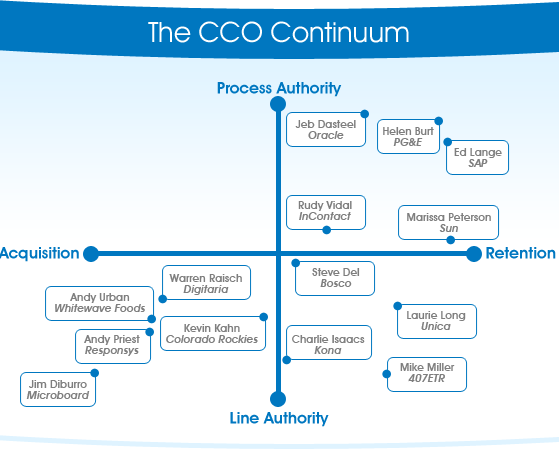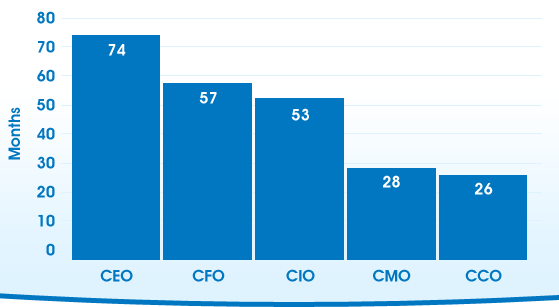Classifying Chief Customer Officers
Types of CCOs
The CCO role has matured significantly in the past six years. CCOs used to have discrete job functions and could be classified into one of three types: Service Driver, measured according to service revenue and customer retention efforts, Sales Driver measured on revenue/new account growth, and Generalist with a dual focus on both acquisition and retention.

In recent years the role hase become more complex. The demarcation between the discreet types is blurring, with more CCOs leveraging customer insight to drive unified customer strategy through both acquisition and retention efforts. CCOs can be classified according to two axes as shown in Figure 1: The CCO Continuum. The horizontal axis represents the split of responsibility between customer acquisition and retention activities particularly those measured by the specific performance indicators they are held accountable for. The vertical axis classifies type of positional and organizational authority.
Line Authority
Many CCOs, especially those in smaller companies have “line authority” over many of the customer-facing functions in the company. These may hold EVP of Services or EVP of Sales titles in addition to Chief Customer Officer. With this positional authority, it is easy to shape employee behavior to better serve customer needs and improve the customer experience. However, there are still customerimpacting processes that lie within other departments such as billing, product development, R&D, etc., making it impossible for the CCO to truly control all functions that shape the overall customer experience.
Process Authority
The greatest challenge for CCOs having line authority is that the model cannot scale as the company grows and the demands on the CCO increase. With growth comes the need to sacrifice line authority for vast matrix authority over task teams brought together to resolve specific issues.
Rudy Vidal, in addition to line authority over services, has “process authority” throughout the entire customer value chain. This means that even though he doesn’t directly control resources, with this CEO-given mandate, he can examine and drive improvements in any process at any customer touchpoint to improve the overall customer experience.
The CCOs acquisition/retention ratio can be plotted on the horizontal axis of the CCO Continuum. Jeb Dasteel spends approximately 30% of his time on customer acquisition and the remainder in customer retention efforts. Jeb’s role is a pure staff function; he and his team help business units gather customer insight to refine process as part of the overall customer strategy. Jim DiBurro, CCO and VP of Sales for Microboard Processing until December of 2008, was nearly 100% focused on new revenue and held line authority over the entire sales organization, placing him at the far lower left quadrant. While still at Sun, Marissa Peterson had significant line authority as the EVP of Worldwide Operations in addition to her staff role as CCO. As CCO she focused the vast majority of her time on overcoming quality issues for existing customers. In general, small and mid-cap company CCOs are often found below the horizontal (more line authority). Small company CCOs frequent the lower left quadrant (more focused on customer acquisition). Larger company CCOs tend to be clustered to the right of the vertical towards customer retention, and almost all are found in the upper right quadrant by virtue of their staff function.
CCO Distribution by Company Size
In 2003, there were only four Fortune 500 companies with CCOs: Cisco, Sun, HP, and Pacific Gas & Electric. Of the more than 300 CCOs identified as of mid-2009, it is surprising that fewer than 25 of the Fortune 500 companies have a CCO, and only another two more are found in the ranks of the Fortune 1000. In fact, CCOs are found in only 39 companies with annual revenues greater than $2 billion.
Larger companies experience a greater payoff for installing a CCO than many because the loss of a single, large B2B customer or distributor can be devastating to their business. In addition, large companies tend to stratify away from customers, focusing on self-perpetuating behavior at the expense of customers. They lose sight of current and future needs, lose relevance in the eyes of the customer and are more vulnerable to competitive poaching.
CCOs of large companies have the greatest challenge in changing an ingrained culture, much like turning a supertanker on the open seas. Oracle, long known for aggressive sales behavior, received a huge boost when they acquired PeopleSoft, a very customer-centric company and another boost upon acquiring the highly customer-focused Siebel. After a string of acquisitions, more than one in three employees are from another company. With this assimilation of customer-centric employees, CCO Jeb Dasteel states that Oracle has been able to make enormous strides in driving customer-centric strategy and culture, which aids the retention of nearly 100% of newly acquired customers.
It is far easier to install a CCO in a smaller company of perhaps less than $100M in revenue, often because the CCO can directly influence all the employees. The CCO can more easily establish and enforce policy. However, these CCOs are often resource-starved. In one extreme case, the company failed because the growth rate surpassed the CCOs ability to support and sustain current customers, destroying customer relationships and resulting in their defection.
The greatest concentration of CCOs is found in mid-size companies. These companies tend to have the maturity to avoid the “growth at all costs” mindset, the resources to support the CCO and care for customers. They also have the willingness and resources to invest in customer measurement and improvement. And they have few enough employees to easily shape behavior around customer needs.
CCO Distribution by Industry
From their beginning, Chief Customer Officers have consistently been found most often in the ranks of technology companies. However, as the role matures, CCOs are leading the customer-centric charge in a multitude of industries, including public utilities which were previously thought to never be receptive to a CCO.
During the early days of the dot com era, many new companies started out with a CCO as an ideal model for business organization. Starting from a fresh slate, the companies were easily able to install a CCO and prepare for customer-centric growth from the outset. However, after the dot com bust this model receded dramatically, and many CCOs were left on the streets. Yet, their legacy remains in the fact that technology companies tend to recognize, perhaps due to the remarkably high lifetime value of existing customers and the intense competition for new customers, that a Chief Customer Officer can engender loyalty and drive revenues.
Given the extreme regulation and the seemingly monopolistic nature, it might seem surprising to find that CCOs are making inroads into public utilities, like PG&E, Arizona Public Service, NE Utilities, and more. Despite deregulation efforts, the practical reality is that most public utilities have little to no competition for customers. If you reside or do business within the service area you are a de facto customer.
So why does a utility need a Chief Customer Officer if not to prevent customer defection or increase customer loyalty so as to gain a greater share of wallet? Because the utility needs customer goodwill in order to win approvals from government regulators, who are much more receptive to such requests if the utility customers are happy with the services they’re receiving and not complaining loudly to the commission.
Consumer Packaged Goods companies are also heavily represented by Chief Customer Officers. Companies like Coca-Cola, Pepsi, Frito-Lay, Campbell’s Soup, and others have CCOs. In some of these companies the CCOs are heavily involved in anthropologic customer research, examining customer behavior and buying habits. In other companies, the CCO is focused on working with distributors to learn, develop, and share best practices to aid all in the goal of selling more products.
While still claiming technology as a bastion, as the CCO role matures, it is expanding into many new industries, including insurance, healthcare, and professional services (called a Chief Client Officer).
The Average Tenure of the CCO
The CCO role is the most fragile in the C-suite, with an average tenure of approximately 26 months, with some notable exceptions on either side of the average. Previously, the CMO was the most fragile, but in recent years as the CMO role has matured significantly and has been gradually inching upwards in recent years.
There are a remarkable number of CCOs that are relatively new in their job in the past two years, indicative of the wider understanding and acceptance that the CCO role is enjoying. Kevin Kahn of the Colorado Rockies currently holds the record as the longest-lasting CCO, having been appointed in 1998.
Approximately 60% of CCOs are promoted from within and the remainder is hired from the outside. Jeb Dasteel, CCO of Oracle mentioned the greatest challenge of his job is the sheer size and complexity of the company and his job. Marissa Peterson, former CCO of Sun credits her significant operations background with Sun prior to becoming the CCO as a key part of her success during her tenure. Given the complexity, promoting from within certainly makes sense. However, many CEOs bring someone in from the outside because they feel the need for a fresh, more customer-centric perspective.
Given the extreme scope of the CCO role, the massive potential for error given such intimate connection with customers, and the fact that CEOs and Boards don’t yet know how to effectively manage the CCO, it is not surprising that the tenure is so low.
It is the objective of the CCO Council to ensure that this tenure rises through better definition of the CCO role, establishment of clear performance metrics, and through the provision of best practices and CCO Roadmaps that CCOs can follow to ensure their long-term success.

Source: WSJ, CIO Magazine, Spencer Stuart